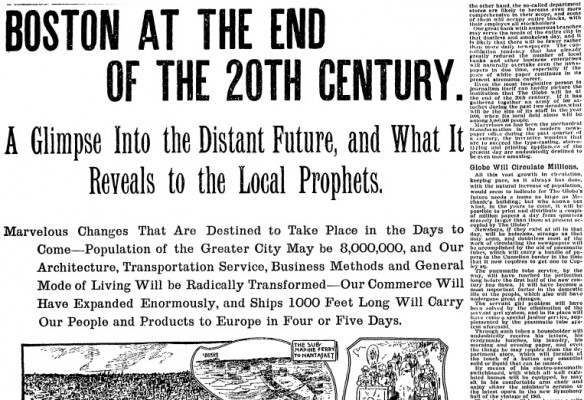Throwback Thursday: What People Thought Boston Would Look Like by Now
It’s December. Let’s put the Old State House Time Capsule aside for a moment. It’s a natural time to think about what our future might hold, and as a healthy reminder that our predictions can turn out wildly off the mark, let’s look at a Boston Globe article from the year 1900, envisioning the Boston of 2000.
On December 24, 1900, author Thomas F. Anderson published the article “Boston at the End of the 20th Century.” Anderson interviewed experts in a range of fields to get their predictions on the future of Boston. He got some things right: he predicted a version of cell phones, air conditioning, and nighttime baseball games. But on other matters, he was pretty optimistic, or just plain off-the-mark.
Anderson had supreme confidence in the continued relevance of the U.S. Post Office, for instance. He was pretty sure we’d live in a city where pneumatic tubes—the kind you see at the bank drive-through—would provide a major means of transporting goods straight to our doors.
The pneumatic tube service, by the way, will have reached its perfection long before the first half of the new century has flown. It will have become a most important factor in the domestic life of the people which also will have undergone great changes.
Through such tubes a householder will undoubtedly receive his letters, his readymade lunches, his laundry, his morning and evening paper, and even the things he may require from the department store, which will furnish at the touch of a button any essential solid or liquid that can be named.
We suppose Anderson was on the right track in thinking that Boston residents would get their news delivered to their laps more than once a day. He just couldn’t envision a world in which e-mail existed. In fact, Anderson went all-in on the future of the Post Office.
I do not anticipate that the cheapening and extension of the telegraph or telephone service is going to adversely affect the number of letters written and mailed in the future. On the contrary, the cheapening and improvement of the postal service may operate as a factor against the growth of the other service.
Goofy as that may seem, he was actually pretty accurate on some fronts. In a time before even Fenway Park was built, he wrote: “Most of the baseball cranks of today are confident that the national game will continue to hold its prestige through the coming century, and that it is likely to be played at night as well as by day.”
He foresaw air conditioning, too, arguing that it “will be possible to turn on an imitation east wind at any time the outside temperature reaches an uncomfortable height.”
He was right about the future of Boston’s civic buildings:
The man or woman who views from the state house dome the great city of Boston in that day will see many fine public buildings that do not exist now, including a new city hall…
Sure, though he couldn’t have envisioned how ugly the new city hall would be.
Anderson’s predictions stretched on for columns and columns of that day’s Globe. (It’s searchable to Globe subscribers and Smithsonian magazine excerpted more bits from it several years ago.) The piece ends up providing, ironically, a lot of insight into the state of Boston of 1900. By seeing what questions he asked and which aspects of Boston he thought might change, we actually learn more about the Boston of his time than he was able to tell us about Boston in our own.



